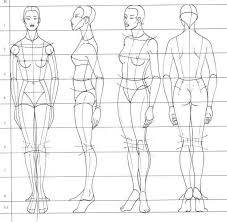Before you can draw a human figure with clothing, muscles, shading, etc., it is necessary to understand the basic proportions of the human figure. Proportions on a figure are simply how long the major anatomical parts of the body are, in relation to each other.
Let's examine the proportions of a healthy male human figure. Proportions change based on body type, age, sex and activity level. Our example healthy male figure will be seven heads tall. As a foundation, let's start with these lengths that are all the same. Each of them are two heads long.
1. From the middle of the kneecap to the bottom of the foot
2. The head of the femur to the kneecap
3. The elbow to the tips of the extended fingers
4. From the collarbone to just below the belly button
5. The width of the chest from shoulder to shoulder.
Tip #1 - The width of the hips is the same as the distance from the crotch to the knee.
Tip #2 - The length of the arm from the pit to the tip of the extended fingers is the same as from the base of the neck to the bottom of the buttocks.
Tip #3 - The arms should hang with extended fingers, to the middle of the thigh.
Tip #4 - The elbow should rest parallel with the bottom of the rib cage.
Tip #5 - The size of the foot should fit in between the base of the palm and the pit of the forearm.
Tip #6 - The hand from the base of the palm, to the tip of the fingers should fit on the face, from hairline to chin.
These proportions are critical to learn if you want your figures to look convincing. The reason this is essential is that you cannot place a bone or muscle group on a figure and have it be the wrong length without making your drawing stand out because it will look "off".


